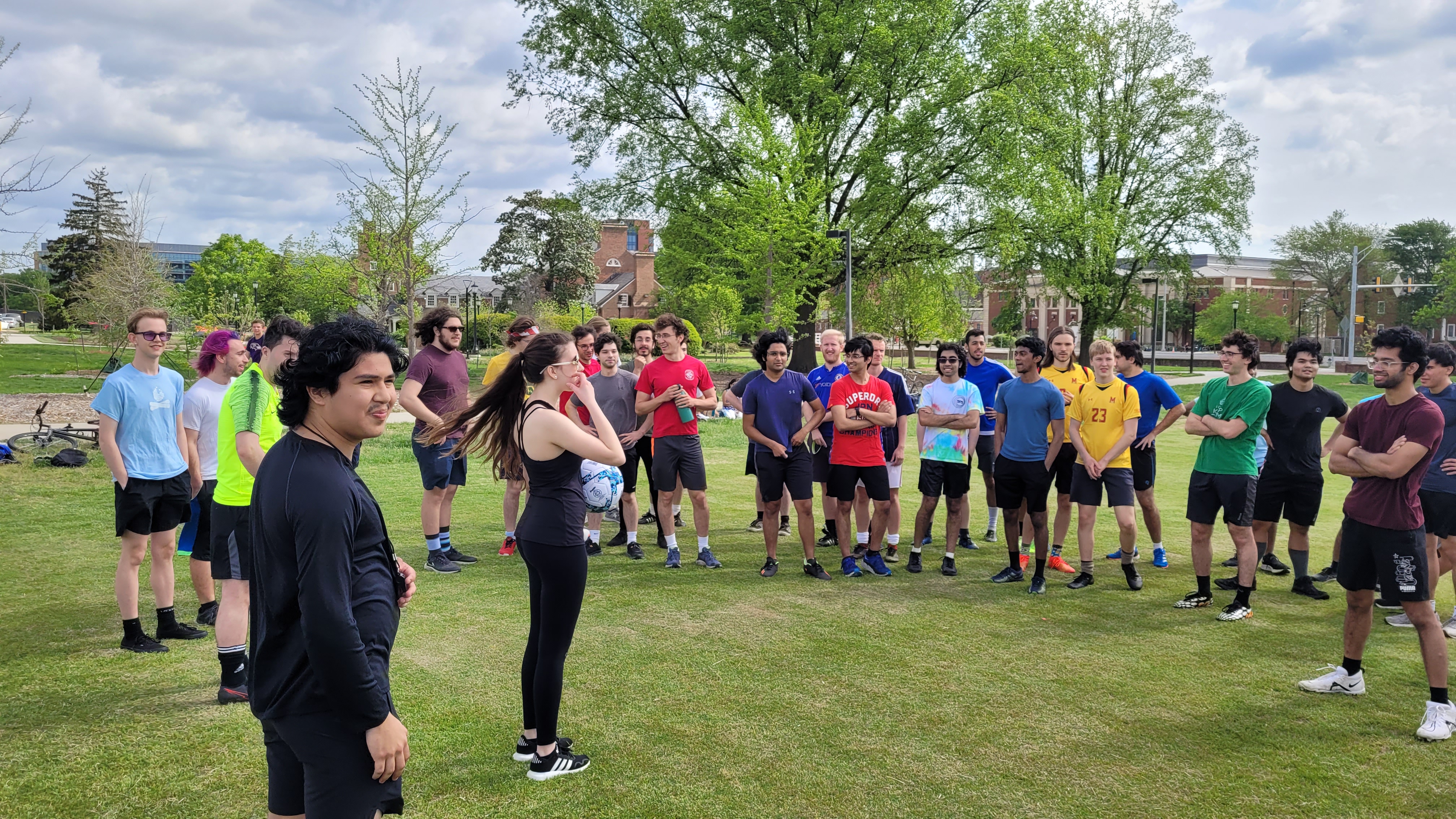Physics on the Field
As co-president of the UMD Physics Undergraduate Committee and a promising researcher, junior Sarah Waldych works to make physics fun for everyone.
On a Saturday in April 2023, an unusual event unfolded on the grassy greens by the University of Maryland’s Memorial Chapel. Nearly 50 students, staff and faculty gathered to play in the inaugural Physics Champions League, an amateur soccer tournament run by the UMD Physics Undergraduate Committee (PUC). Created to bring together physics majors looking for some outdoor fun, the tournament also welcomed the greater campus community, plus friends and family, to participate.

For junior physics major and PUC co-president Sarah Waldych, the idea for the tournament began last fall when she overheard classmates chatting about soccer between classes.
“I realized that a lot of us enjoyed playing soccer in our free time. Many physics majors are involved in intramural sports,” Waldych explained. “Once that clicked, it seemed so obvious to me that we had to organize a way for all of us to come together and just have fun. And it just took off from there.”
Waldych still remembers the excitement and cheering crowds from that spring afternoon. She and other PUC members ran the whole event, from facilitating team sign-ups to refereeing the games. Although many of the players were physics undergrads, graduate students, non-physics students and even a faculty member—Physics Assistant Research Professor Chandra Turpen—played on the soccer pitch that day.
The Physics Champion League is just one of Waldych’s ideas on how to connect students outside of the classroom and build a better, stronger, tighter-knit physics community. As a member of PUC, Waldych helped organize many other programs and events for physics majors—from free hot chocolate and games during exam times to undergraduate research colloquia that help students practice their presentation skills.
“Growing up, I realized that there wasn’t much of a science community for me to really share my experiences with. In fact, there’s sometimes a taboo about physics; it’s too hard, too intimidating, too unwelcoming, or not fun at all,” Waldych explained. “I want to help create a space where we can gather, get to know each other, share research or present anything that we find interesting, and help each other grow.”
To reach those goals, Waldych often collaborates with Donna Hammer, the director of education programs and public engagement in physics and PUC advisor. Together, they work with students, faculty, staff and alums to ensure their needs—both research-related and recreational—are met. Hammer believes that Waldych’s work is essential to maintaining a physics community that is both vibrant and diverse.
“Sarah’s sincere and tireless effort to make sure all physics majors feel included and their accomplishments celebrated is truly outstanding,” said Hammer. “She’s not only committed to her studies and research but also to her peers and the broader physics community.”
A journey to Germany
This summer, Waldych focused her outreach efforts on the broader physics community, spending two months in Hamburg, Germany, at the Deutsches Elektronen-Synchrotron (DESY), a national research center operating particle accelerators and conducting groundbreaking research in particle physics. Waldych worked with the Compact Muon Solenoid (CMS) experiment, a general-purpose detector at the Large Hadron Collider that can see a wide range of particles and phenomena produced in high-energy collisions.

“I worked with the scientists at DESY and students from all sorts of backgrounds,” Waldych said. “We analyzed the systematics of a custom experimental setup designed to measure a sample’s thermal conductivity, or its ability to conduct or transfer heat. We studied the behavior of sapphire glass under multiple operating conditions and specialized criteria that aren’t usually recognized in commercial settings. Our findings will be used later to calibrate other experimental setups at DESY.”
Waldych will bring her new knowledge and hands-on experience with particle physics back to Physics Assistant Professor Christopher Palmer’s lab, where she studies the Higgs boson, an elusive elementary particle believed to be linked to a field that gave mass to everything in the universe.
“Sarah truly has the potential to become a great physicist,” Palmer said. “I hope that this program gave her the opportunity to see what being a particle physicist is like in the real world beyond the classroom.”
Waldych hopes that she can apply the skills she learned in the lab to practice as a researcher. And she’s hopeful her experiences will also help her develop new plans to make physics more fun and welcoming when she returns to Maryland.
“I’ll still be coming up with ways to support UMD Physics, including holding another Champions League—which we would like to run again next spring—and also promoting immersive learning experiences like the DESY program to other students like me,” Waldych said.







